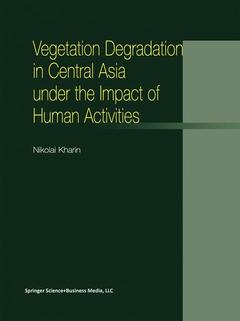Description
Vegetation Degradation in Central Asia under the Impact of Human Activities, Softcover reprint of the original 1st ed. 2002
Author: Kharin N.
Language: English
Subjects for Vegetation Degradation in Central Asia under the Impact...:
Keywords
Vegetation Degradation in Central Asia under the Impact of Human Activities
Publication date: 09-2012
182 p. · 21x27.9 cm · Paperback
Publication date: 09-2012
182 p. · 21x27.9 cm · Paperback
Approximative price 105.49 €
Subject to availability at the publisher.
Add to cart
Vegetation degradation in central asia under the impact of human activities
Publication date: 02-2002
182 p. · 21x27.9 cm · Paperback
Publication date: 02-2002
182 p. · 21x27.9 cm · Paperback
Description
/li>Contents
/li>
This book is about desertification. The author describes vegetation degradation as a part of the integral process of desert ecosystem degradation in Central Asia under the impact of human activities. A connection is made between political and social factors and degradation of desert environments in historical perspective. Fragile desert ecosystems suffer first of all from the loss of vegetation. Wildlife is reduced, productivity of desert rangelands fall and the people also suffer from a shortage of food. The after-effect of this process is catastrophic, not only for the desert itself but also for the people living in the desert. Several measures are also discussed in the book for conservation of desert vegetation and rehabilitation of desert lands.
1.1. United Nations Convention to Combat Desertification (CCD).- 1.2. Global extension of desertification.- 1.3. Change of biological diversity.- 1.4. Degradation of the drylands of Asia.- Physical Environment and Agricultural Development.- 2.1. Introduction.- 2.2. Climate and desertification.- 2.3. Soils.- 2.4. Vegetation.- 2.5. Livestock raizing.- 2.6. Crop production.- 2.7. Pollution of environment.- 2.8. Summary and conclusion.- Historical Interaction of Desert and Society.- 3.1. The first ecological catastrophe in Central Asia.- 3.2. Land use and impact of war during the Middle Ages.- 3.3. Land reclamation, ecology and social life in Russian Turkestan.- 3.4. Aborigines and newcomers in the desert.- 3.5. We shall even control the drought!.- 3.6. Conclusion.- Political, Economic and Social Impact of Land Degradation During the Soviet Period.- 4.1. Large leap — a Central Asian version.- 4.2. Cadre determines all!.- 4.3. Change of social and ecological conditions in rural area.- 4.4. “Pripiska” and its role in land degradation.- 4.5. Conclusion.- Methodology of Desertification Assessment and Mapping.- 5.1. The concept and criteria of assessment.- 5.2. Remote sensing indicators of desertification.- 5.3. Compilation of desertification map of Turkmenistan.- 5.4. Use of NOAA/AVHRR data to study desertification.- 5.5. Multistage desertification monitoring.- 5.6. Conclusion.- Status of Degraded Arid Lands.- 6.1. Change of biodiversity under the impact of desertification.- 6.2. Degradation of forests.- 6.3. Degradation of desert rangelands.- 6.4. Soil degradation.- 6.5. Change of desert environment along the Karakum Canal bordering area.- 6.6. Summary and conclusion.- Change of Wildlife.- 7.1 Animals from “The Red Data Book”.- 7.2 Other species of wildlife standalso in need of protection.- 7.3. Hunting and poaching.- 7.4. Conclusion.- Accumulated Ecological Problems in New Independent Countries of Central Asia After 1991.- 8.1. Sovereignty, poverty and refugees.- 8.2. Scarcity of water resources.- 8.3. Worsening ecological and social conditions in the areas affected by desertification.- 8.4. Enormous economic and social damage caused by desertification.- 8.5. Conclusion.- Convention to Combat Desertification — A Gleam of Hope at the end of the Tunnel.- 9.1. A concept for rehabilitation of degraded desert lands.- 9.2. Regeneration of forests.- 9.3 New approaches and arrangements.- 9.4 National Action Program to Combat Desertification (NAPCD) in Turkmenistan.- 9.5. Creation of enabling environment for implementation of NAPCD.- 9.6. Summary and conclusion.- Synthesis and Conclusion.- 10.1. Lessons of the past.- 10.2. Up-to-date situation.- 10.3. The requirements of future activities in desertification control.- Glossary of Local and Special Terms.- References.
© 2024 LAVOISIER S.A.S.




